.
After spending three delightful days in my beloved Toruń (Poland), plus one more in a collapsed and messy Warsaw, that works in a frenzy for showing a pretty face of progress, developement and modernity to the world and to the hordes of upcoming tourists that will arrive for the UEFA finals, I set forth on a night train with the destination Kiev.
I could have travelled by airplane for only a few euros more, but I opted for the seventeen hours train trip instead of the one hour flight. I love trains, pluse they’re safer, more comfortable and, for sure, less environmentally aggressive than airplanes. When on a train, I feel that I still can handle the rudder of my life, I coexist with other passengers, I’m a human being travelling along the Earth’s surface, progressing along the fields or mountains, enjoying the landscapes; I can pace up and down the corridor, stretch my legs or sleep when I want to… On an aircraft I feel like an air intruder, stuck to a chair hanging on the sky; slave to other’s whims or skills. Since the moment we step on the airport’s departures terminal, we helplessly deliver our freedom, for a few hours, to the hands of other people: security studs, check-in desks’ staff, air hostesses, pilots, and then custom authorities, border officers… We can be denied boarding the plane for no reason, refused our luggage, taken away our property without due explanation, forced to comply with a number of things we don’t have to, and undergo any kind of humiliations. So, I bought a train ticket for Kiev, went to the station –the unusual Warszawa Gdańska– and, without check-ins or boadring cards, without boarding queues, restrictions nor conditions, just jumped into the carriage in the last minute for the pleasure of so doing.
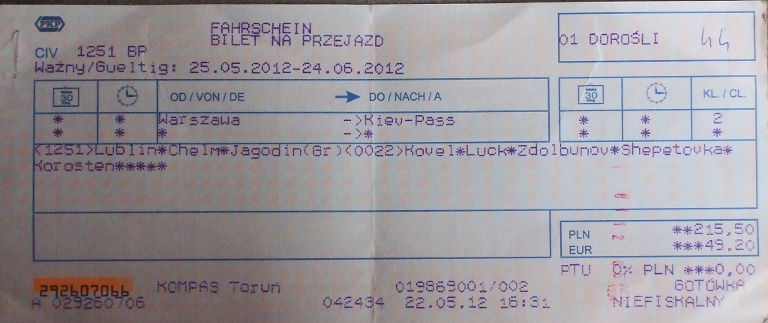
Train ticket from Warsaw to Kiev
It’s a combined train. I travel in the only Ukrainian carriage: the others are Polish. There are three passengers in each compartment. One of my fellow travellers seems mute; the other, a talkative senior, kind and helpful, with whom I communicate thanks to my meager and forgotten Polish. The coach attendant brings tea or coffe, for free, upon demand. The trip is so long mostly due to the border crossing: Poland and Ukraine, historically hostile nations, and afraid of each other, use different railway gauges, rendering it necessary to change the bogies. And there is also the documents checking: Polish officers are usually nice; Ukrainians not so much: they still preserve the manners of the communist times. But no big deal in any case: UEFA is close, and Ukraine wants to show a nice face to Europe. Nevertheless, the whole process takes three hours: the three hours of mistrust.
Finally, next day in the morning, we approach Kiev Passenger train station. The locomotive slowes down and I can shoot the typical ocean of coaches:

A sea of carriages in Kiev Passenger station proximity.
Some people freely crossing the rails:

Approaching Kiev Passenger train station.
or a peculiar railroad building:
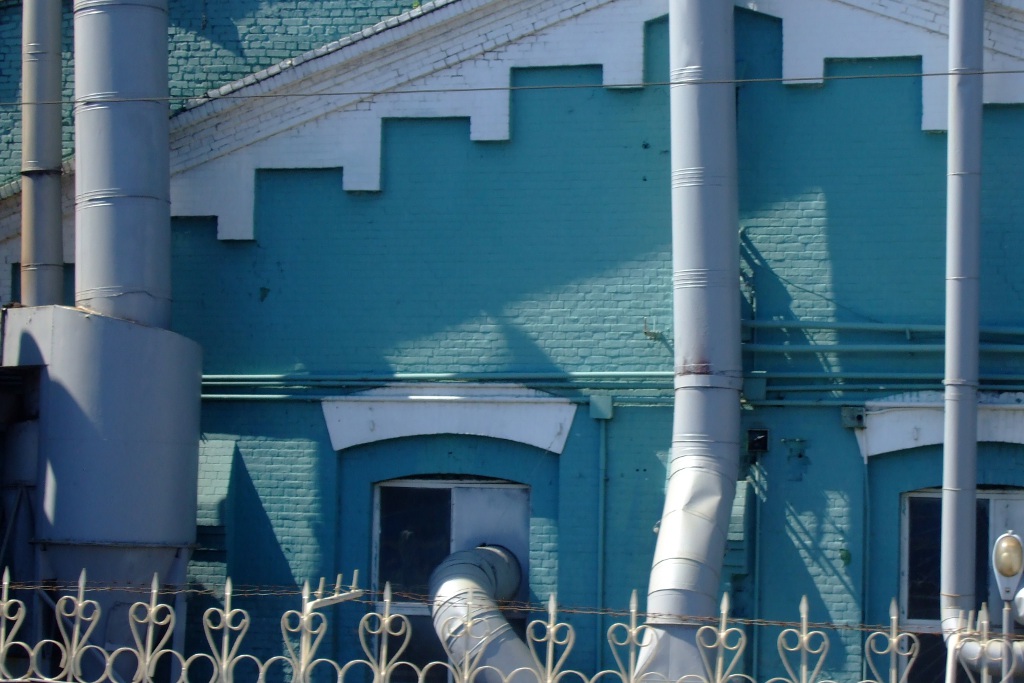
One of the many hangars along the railways near the station.
The train halts. Maria is waiting for me, as she promised. She takes my hand and leads me towards the gothic station building, with its spectacular hall:
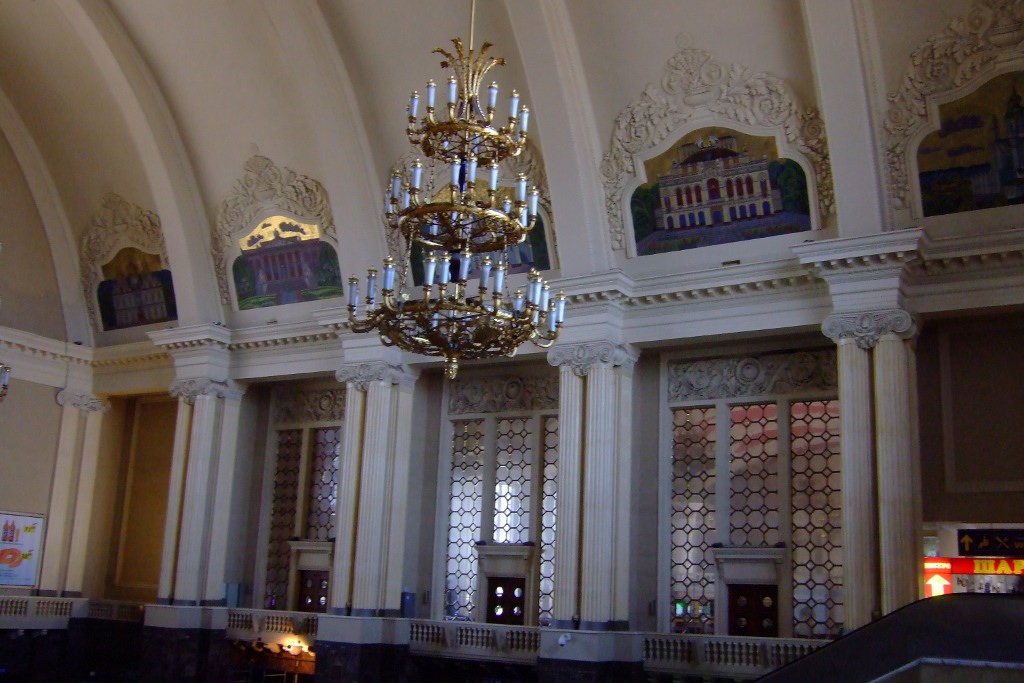
The main hall of Kiev Passenger railway station.
On exiting, we look for some place where to have a cup of tea. You can never be too wrong with a cup of tea.

Our first cup of tea in Kiev.
Once refreshened, we head for the city centre. Lots of informal commerce, small shops, kiosks, irregular stands, and “underground” economy takes place in the underpass alleys leading to the subway.
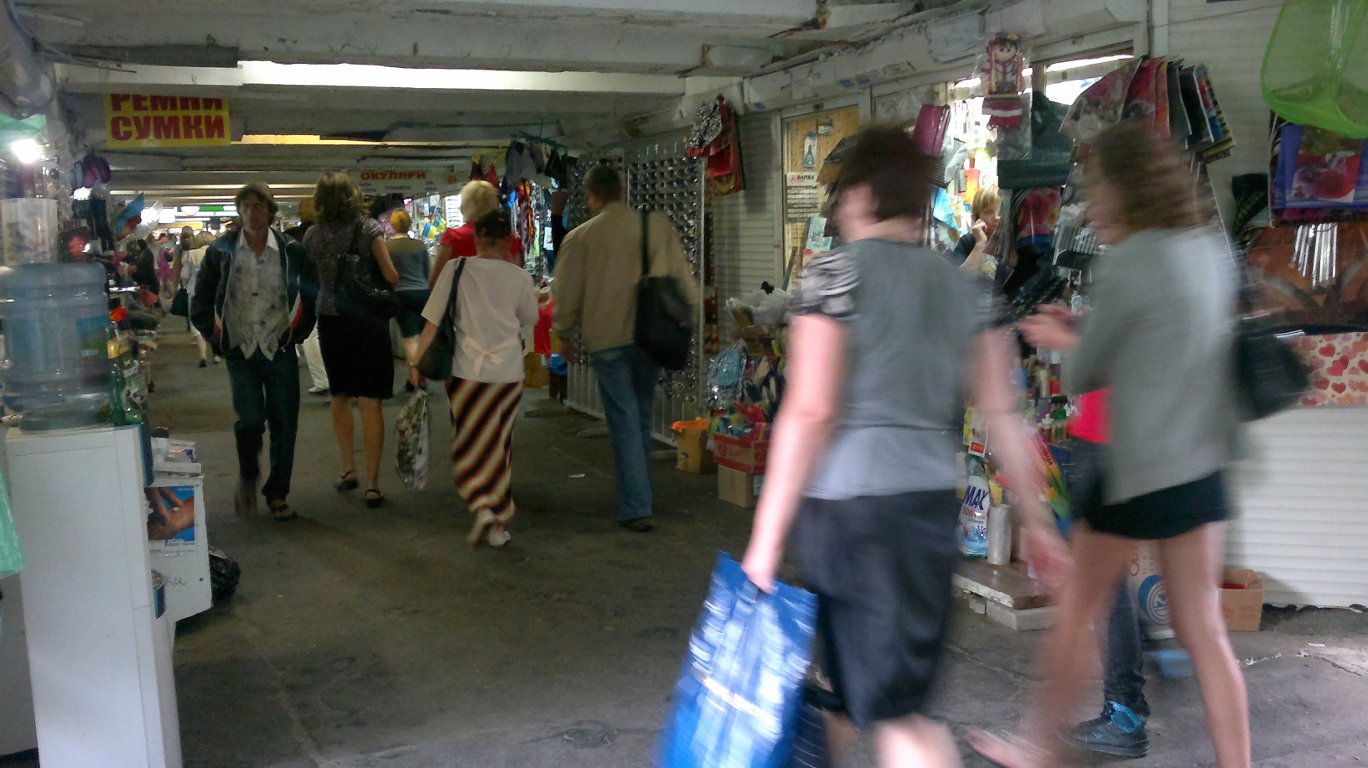
Typical underpass in Kiev.
The underground tunnels, built war-proof and bomb-proof, are so deeply dig that it often takes longer to dive to the platform and climb outside, than the actual time you spend riding between the stations. We go down, down, down like if we aimed the center of the Earth. Most of the scalators have a giddy length:

The endless scalators from above.

Another view of the scalators, this time from down under.
And, well, perhaps this is a good moment for reading you my personal sermon, whose motto is: to hell with growth, progress and developement!
Sorry, but… after taking some distance to these three values, nowadays indisputable, I’ve stopped understanding… what is it with them? Humans have lived for hundreds of thousands years without caring at all about any growth, any progress nor any developement and, as far as I know, there is no evidence at all of humankind being any happier in our times. Do we really need to grow economically? Do we really need to develop our societies? Do we really need to “progress”? What, in any case, does progress mean? Aren’t these terms just euphemisms for justifying the increasing social and economical differences between a society’s citizens? Plus: first, it’s impossible to grow indefinitely in a finite planet, therefore constant growth can only be achieved at the expense of others; and second: what’s wrong with the old and traditional things?
Well, I’ll leave it here before boring the readers to death. Only add that these thoughts were refreshed in my mind when comparing the old and new Kiev subway stations:

Typical aspect of the “old” stations of Kiev metro.

The “modernized” look of the new stations.
Now, please think and reply to yourself: how much have we gained with the progress and developement in this case? Personally I like ten times better the old stations than the new ones. I prefer the aesthetics, the ornaments, the meaningfulness, the cozy feeling of History, the indisputable character of the old stations, than the impersonal, standard, globalized-world look of the new ones.
Out into the daylight again, and we find the ubiquitous florists, the enduring women who spend endless hours trying to sell their flowers to an indifferent crowd of passers by:
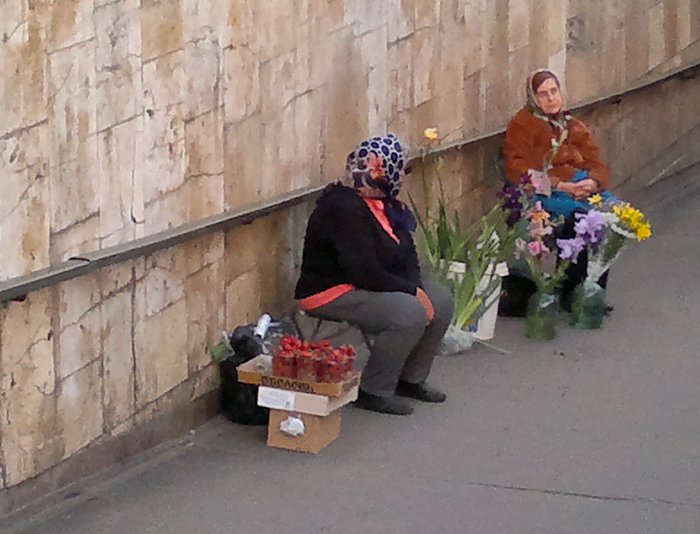
Florists in Kiev’s underpasses.
And step by step, by and by, for along a week Maria and me tirelessly walked up and down Kiev, drawing with our footsteps the random pattern of a leisure time.
Of course, first of all, the city center: the majestic Maidan Nezalezhnosti square:

Maidan Nezalezhnosti
Half an hour walk from Maidan, or two subway stations away, we get to the always busy and often crowded Kontractova Ploscha square, one of the main local communication hubs. Too old a tramway for some of you folks, my dear progress vassals? 😉
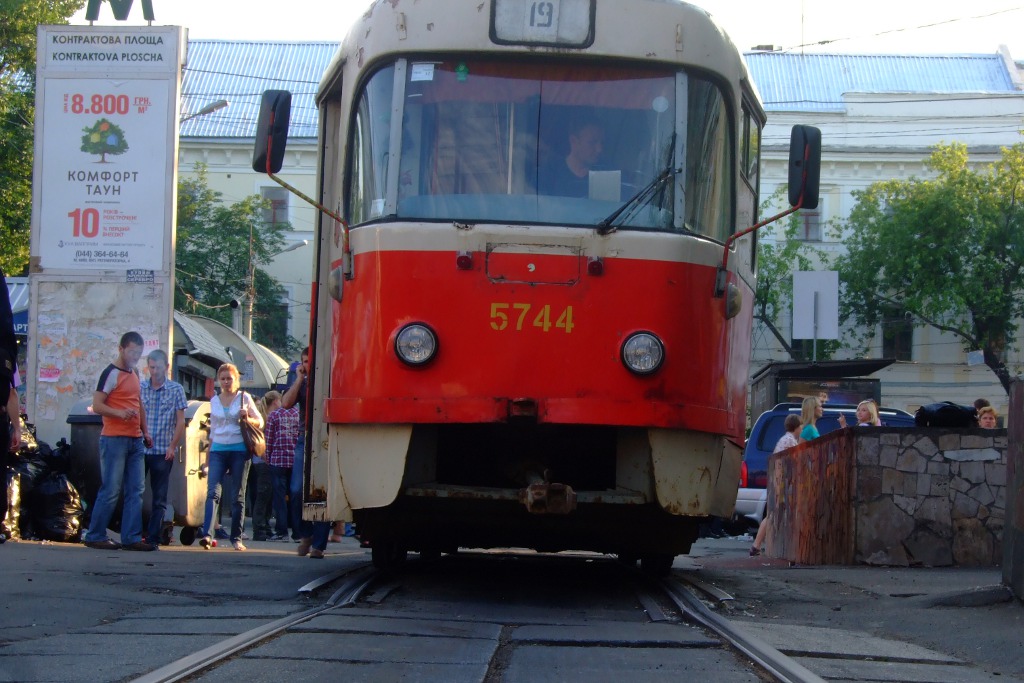
Tramway nr 19 in Kontractova Ploscha
Another half an hour walk away, from Sofiis’ka square, the golden domes of Saint Michael’s monastery outstand behind the monument of Bohdan Khmelnitskiy, the Polish hetman who led an uprising against the Polish-Lithuanian commonwealth which resulted in the creation of the Cossack state during XVIth century, though later on he himself concluded a treaty with Russia which led to submission to this empire, thus losing the recently gained independence.
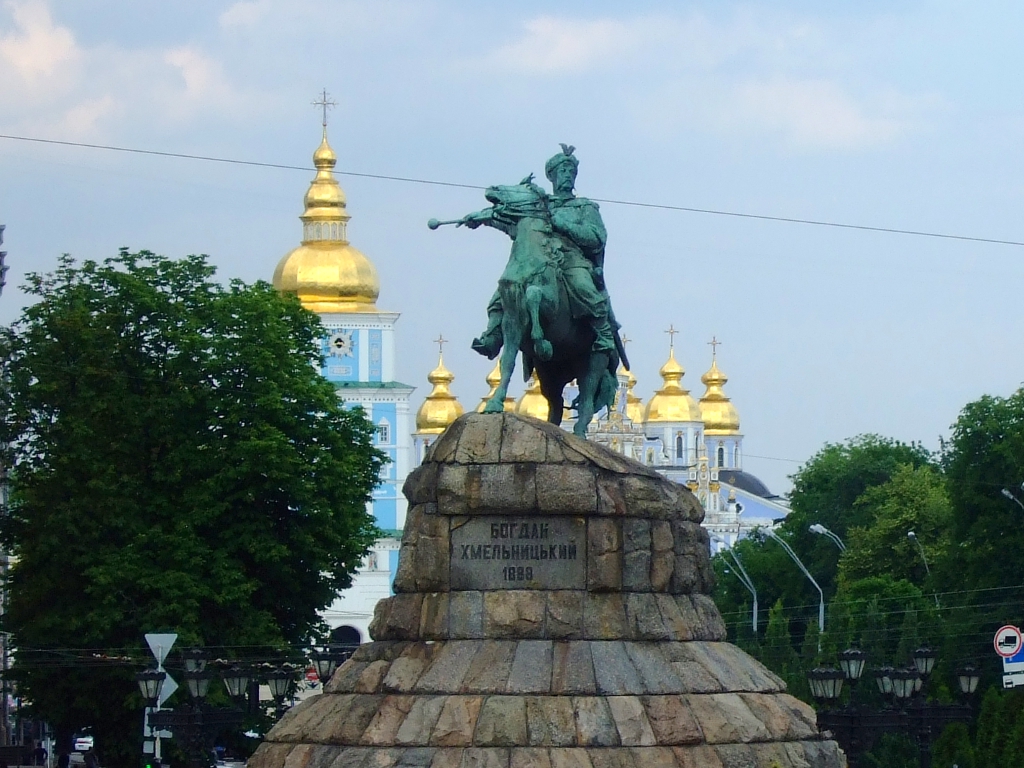
Bohdan Khmelnitskiy monument. St Michael’s cathedral in the background.
To the other side of Sofiis’ka square, the bell tower and main building domes of Saint Sophia Cathedral, Sofia Kiyvska, looks great and appealing under the stormy clouds:
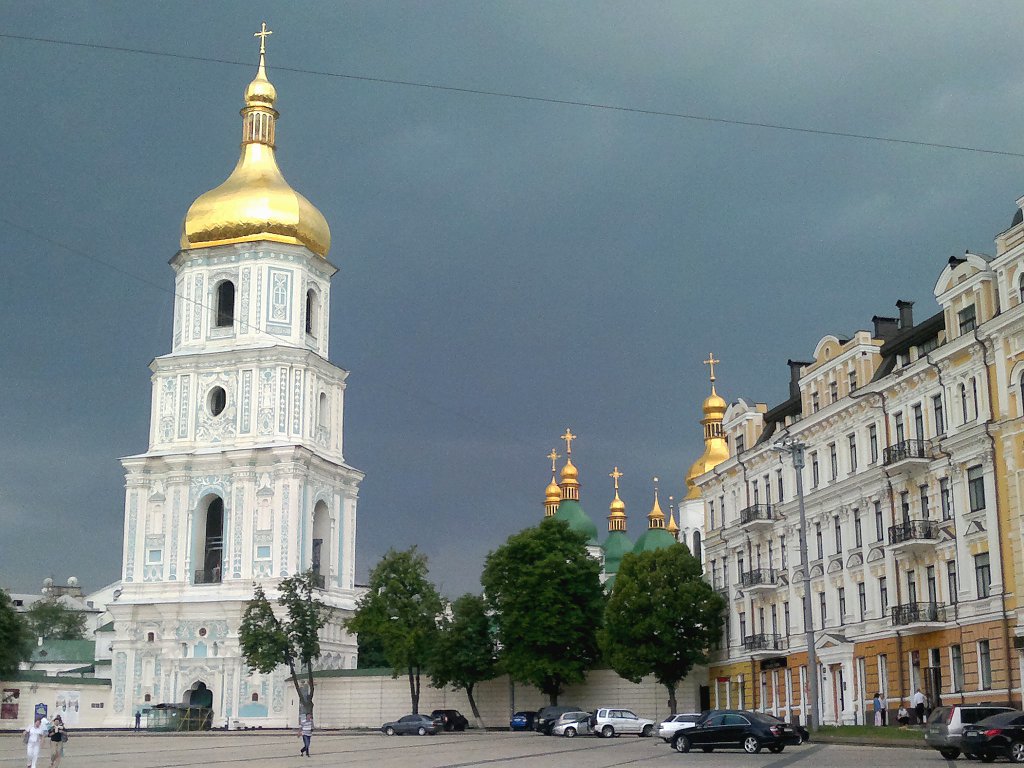
Bell tower and main building domes of Sofia Kiyvska
Well, let’s buy a ticket for paying a visit to this outstanding monument, of which is said that, after the Russian revolution of 1917 and during the Soviet antireligious campaign of the 1920s, the government planned its demolition. It finally didn’t take place thanks to the effort of many scientists and historians.
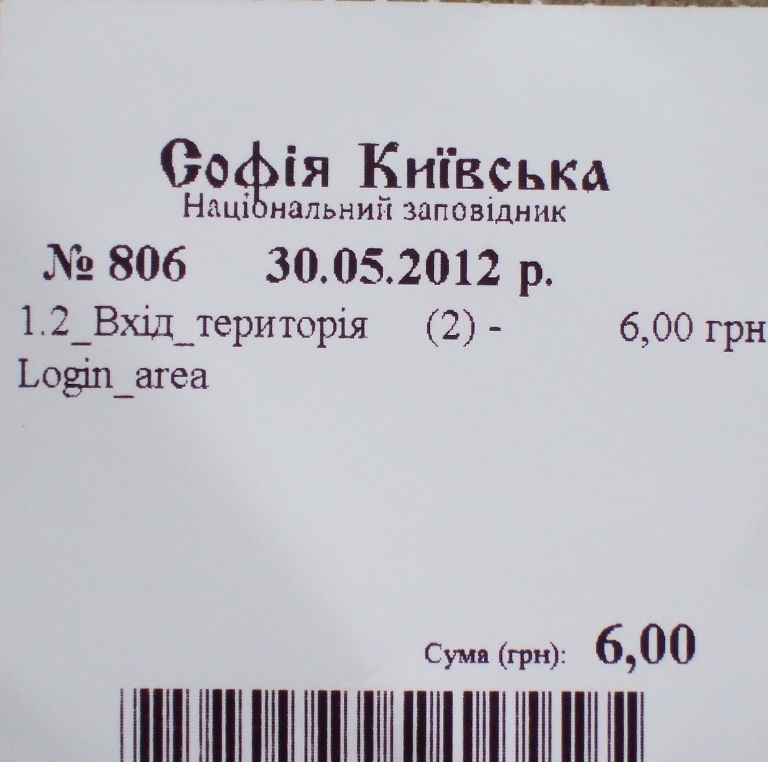
Entrance to the main building, the Cathedral itself:
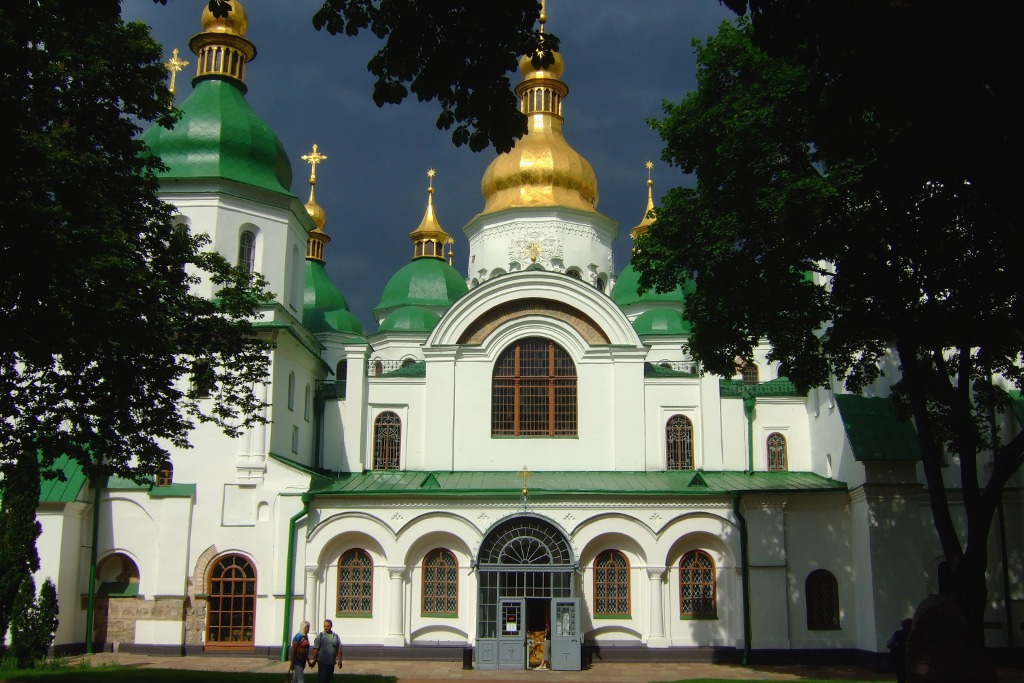
Sofia Kiyvs’ka cathedral
The rear side:
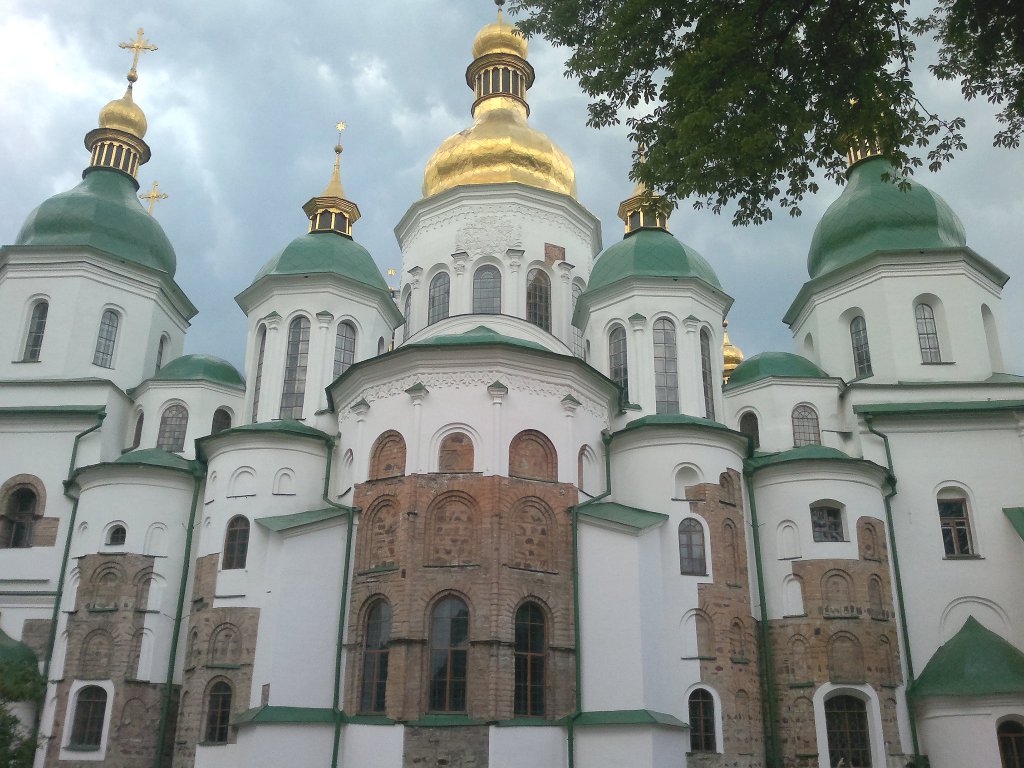
Back side cupules and domes of Sofia Kiyvs’ka
The brotherhood building. Who wouldn’t surrender before the brilliance of its suns? It has to be holy!
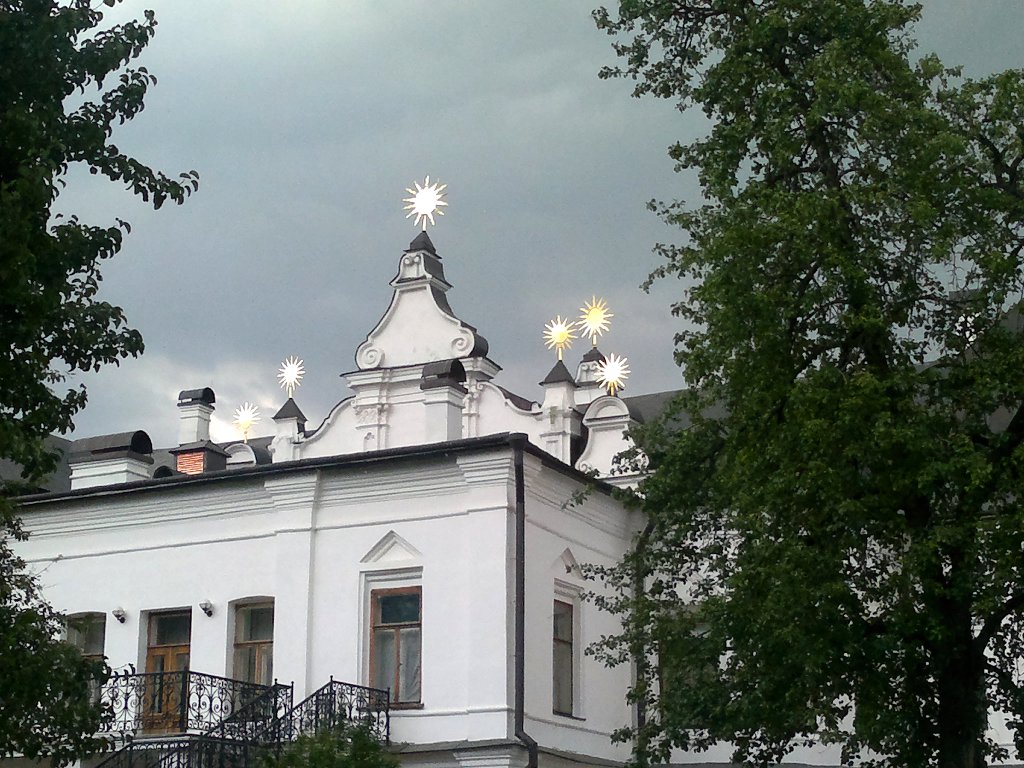
The brotherhood building in St. Sophia cathedral complex.
The monastic inn looks more than inviting…
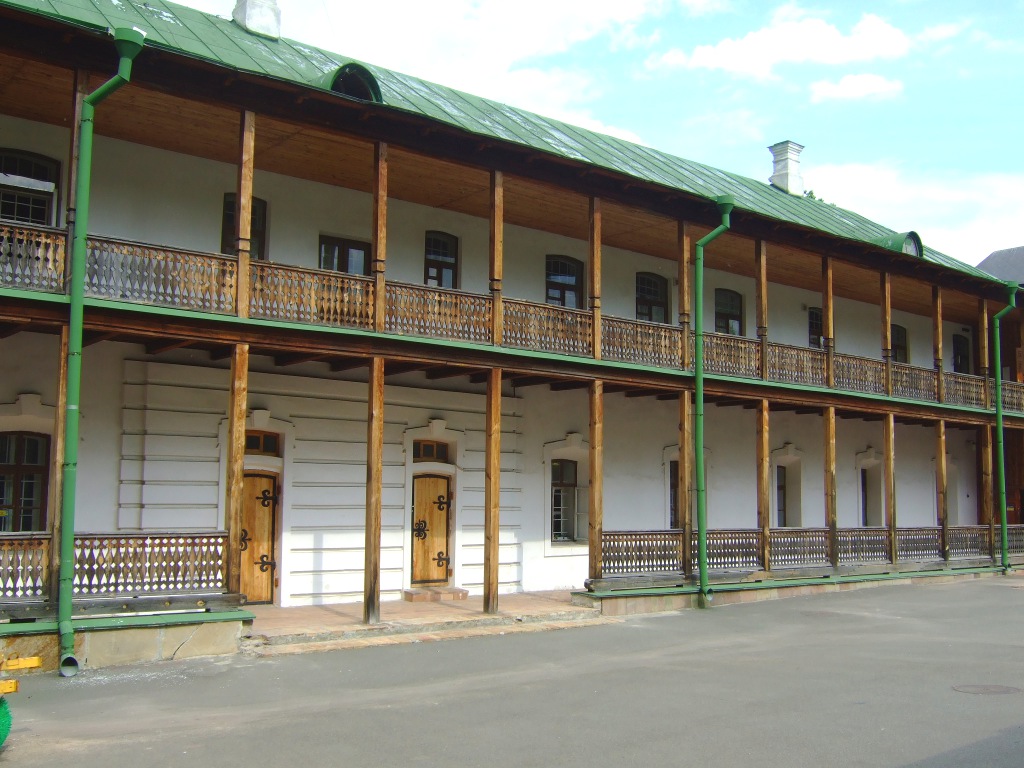
The monastic inn, where monks lived. Sofia Kiyvs’ka.
Now we’re out onto the streets agan. This is one of the many green areas around the historical centre. It started raining and we had to shelter under Maria’s tiny umbrella, same as the couple in this photo:
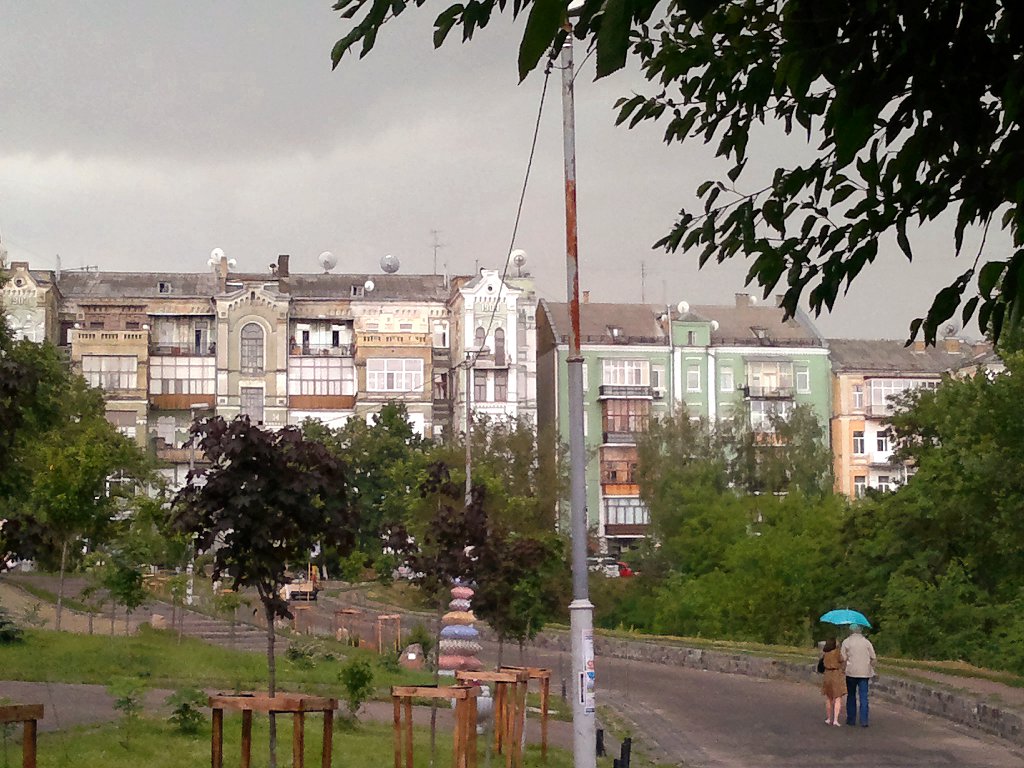
Park and houses in the historic centre of Kiev.
After the rain, the awesome sudden view of fairy tale Vodzvyzhens’ka street, in a forested valley among two of the seven hills upon which –the legend says– the city was founded:
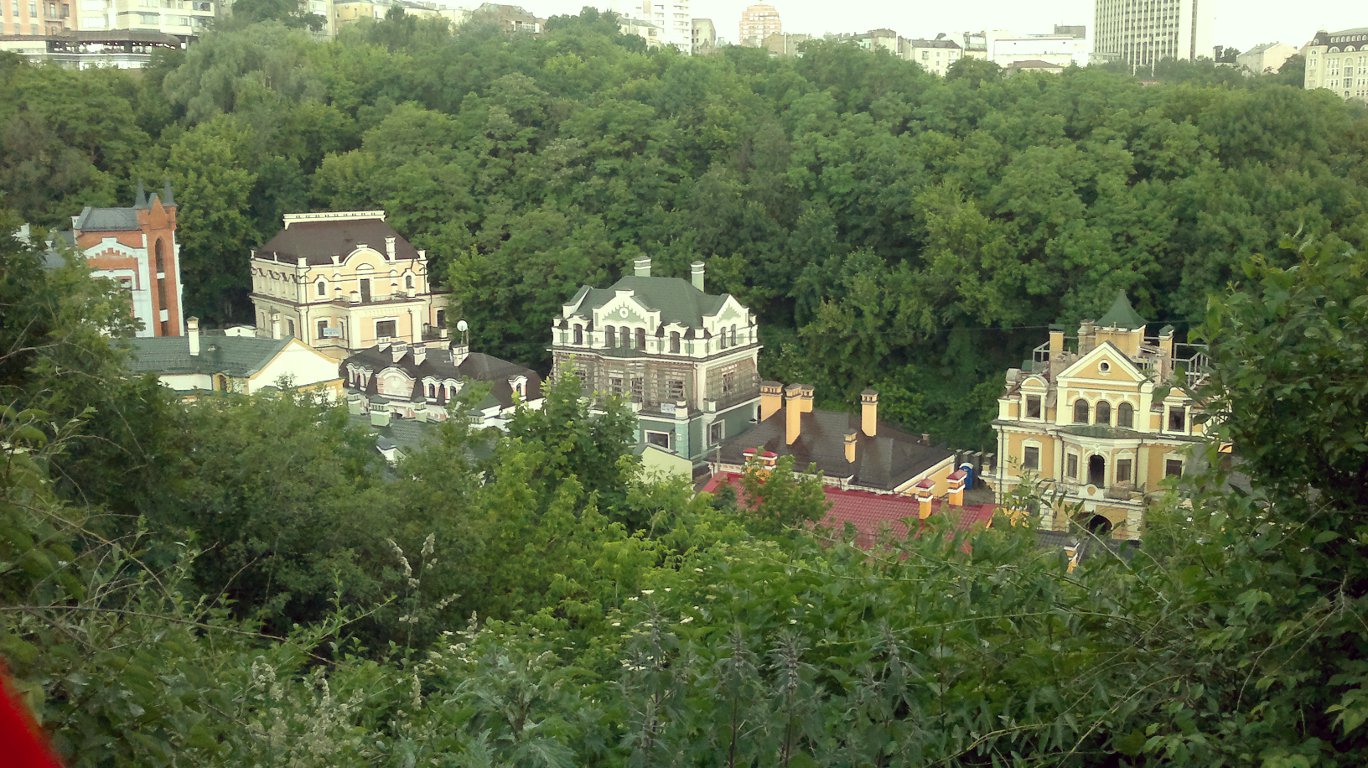
Fairy-tale Vodzvyzhens’ka valley among the forested hills.
And, then, some of the many nice buildings in the beautiful Andriivs’kyi descent, the main tourist trap of Kiev, fortunately empty that day because of the rain:

Andriivs’kyi descent.
Another day, and quite another facet of Kiev. The striking contrast between the decaying aspect of some buildings, the general poverty, and the wealth shown by the abundance of expensive cars.
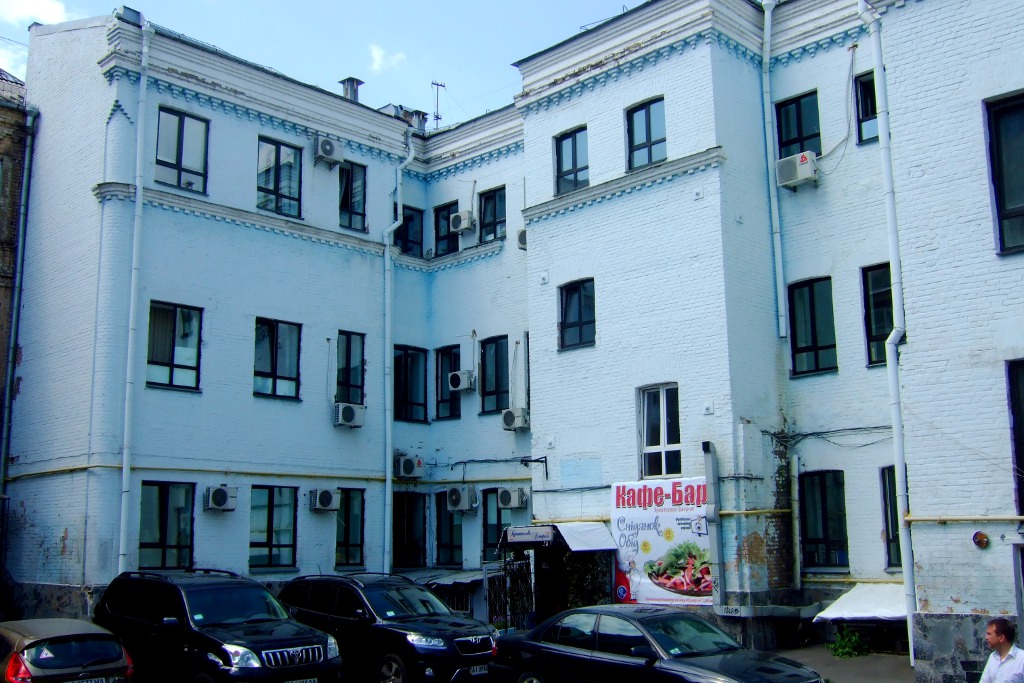
Wealth and poverty. Expensive cars parked in a dirty backyard.
This one doesn’t look like very earthquake proof, huh?
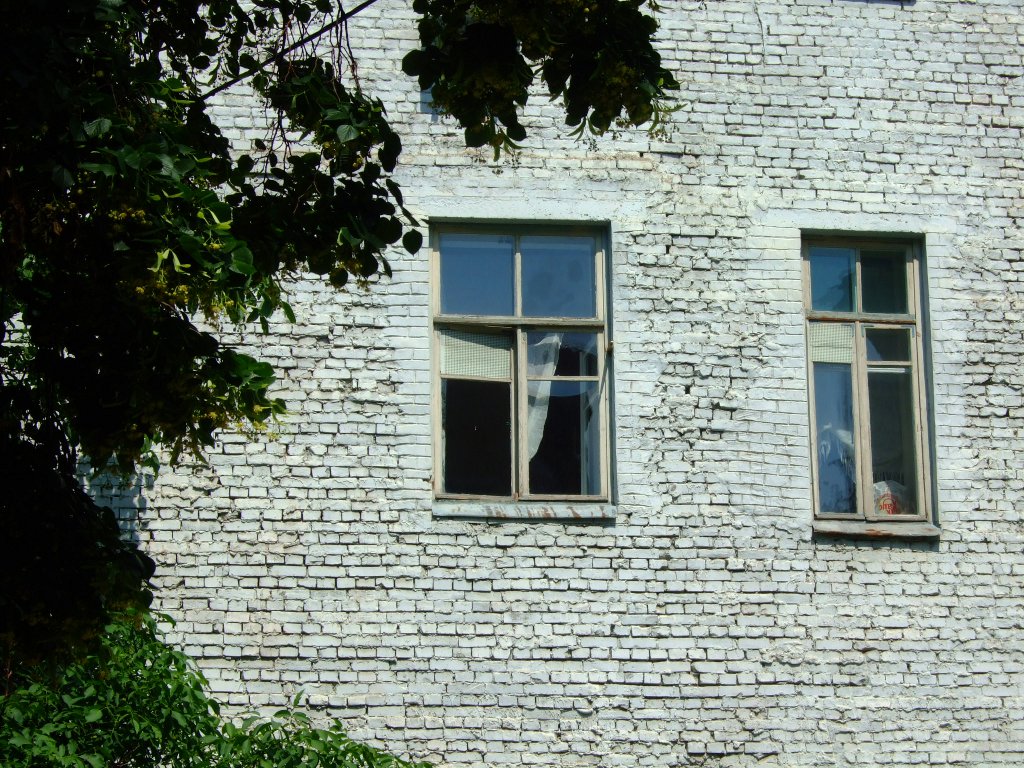
Bricks. Detail of an old building’s side.
We also went building-hunting. This one shows the decadence of what once was opulence:
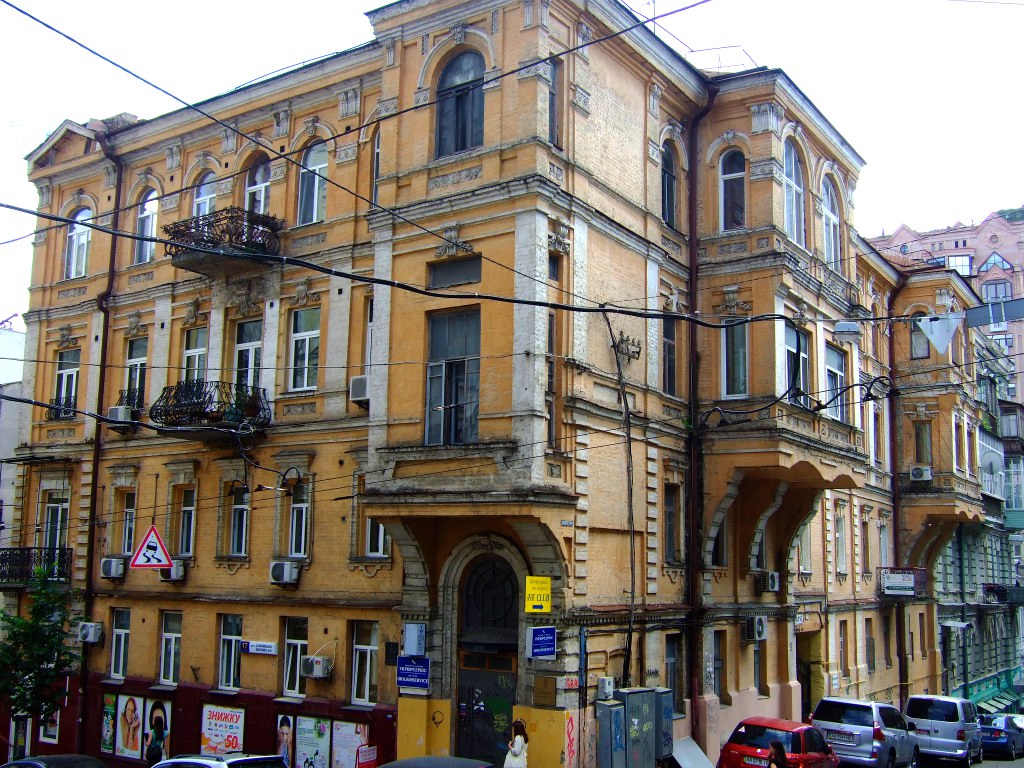
A beautiful neglected building.
Some look still magnificent, most of all around the city centre (of course with the help of some paint, special for the occasion, the UEFA finals).
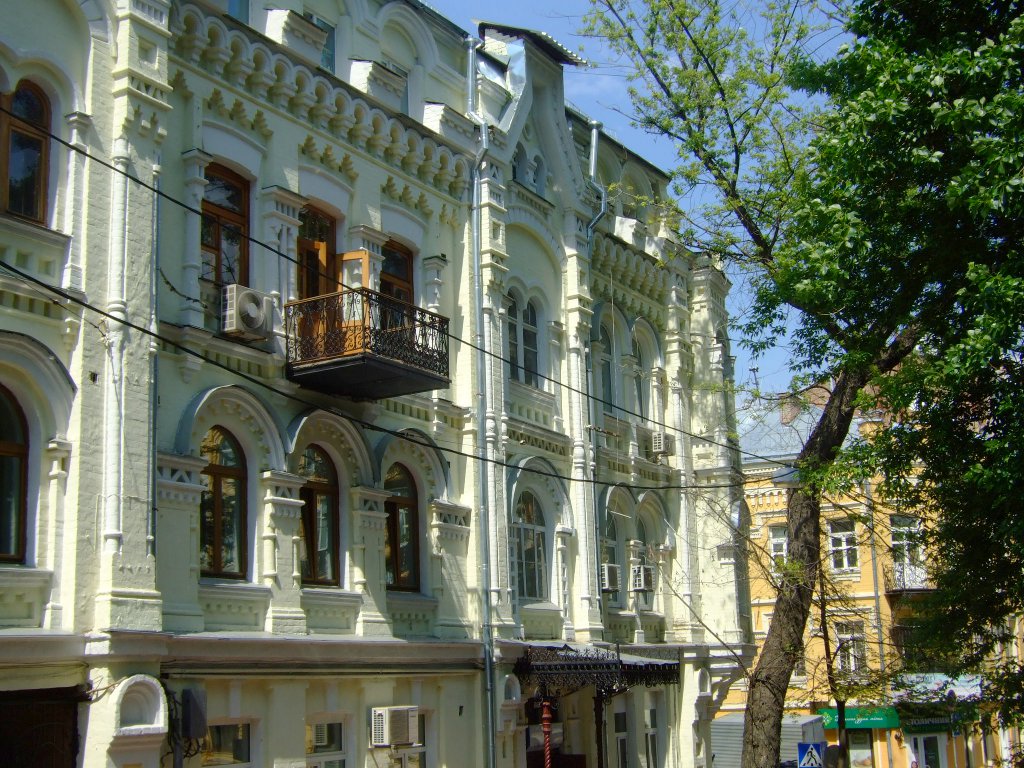
One of the buildings facing Ivan Franko square. Kiev.
One of the best views, on top of Andriivs’ka descent, with Saint Andrews cathedral’s domes in the background.
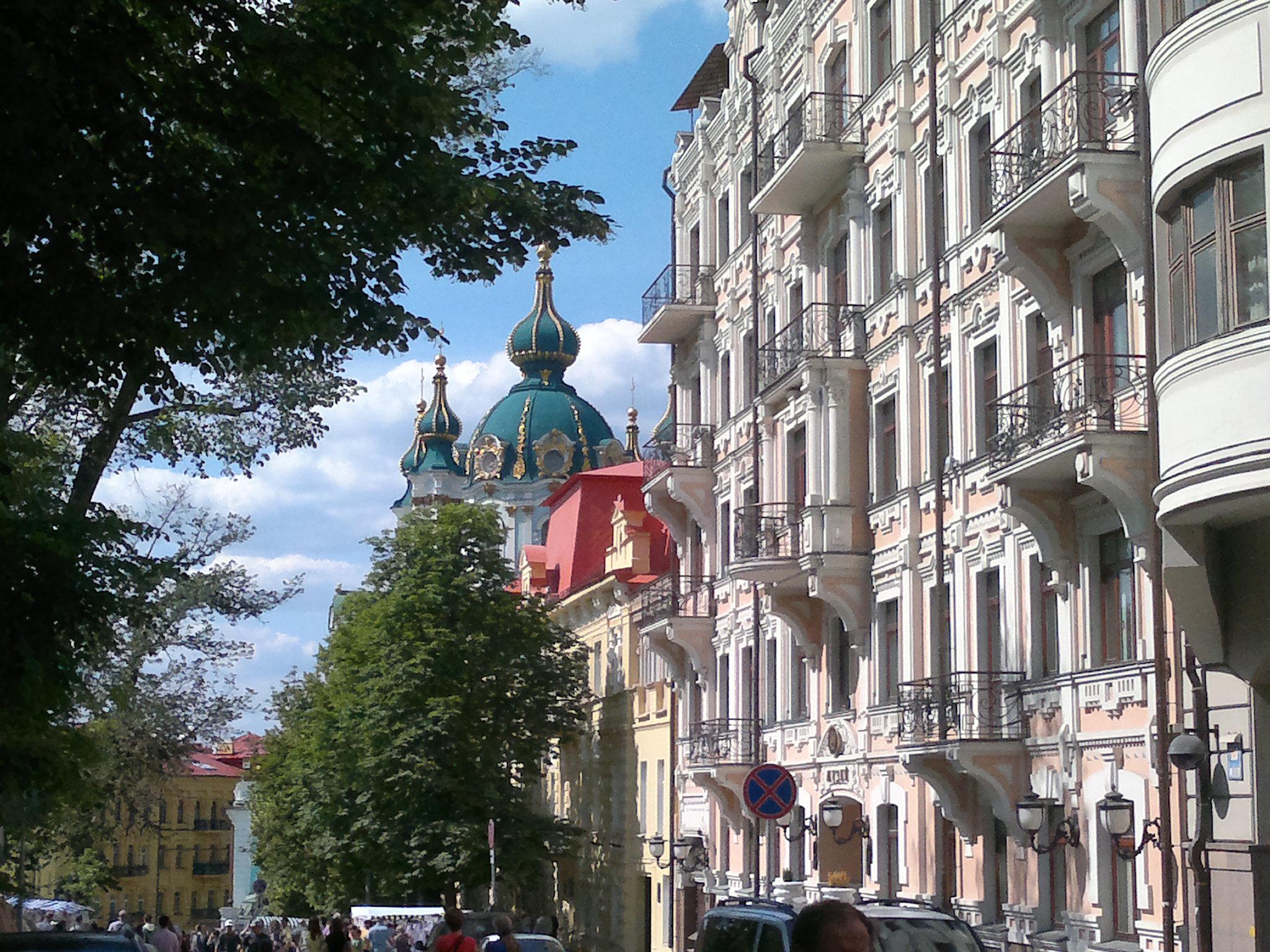
Heading to Andriivs’ka descent. St Andrew’s cathedral in the background.
This is a nice building in Ivan Franko square. Late doctor of philosophy Ivan Franko is one of Ukraine’s heroes: poet, writer, social and literary critic, journalist, economist and radical political activist, he founded the socialist and nationalist movement in western Ukraine.
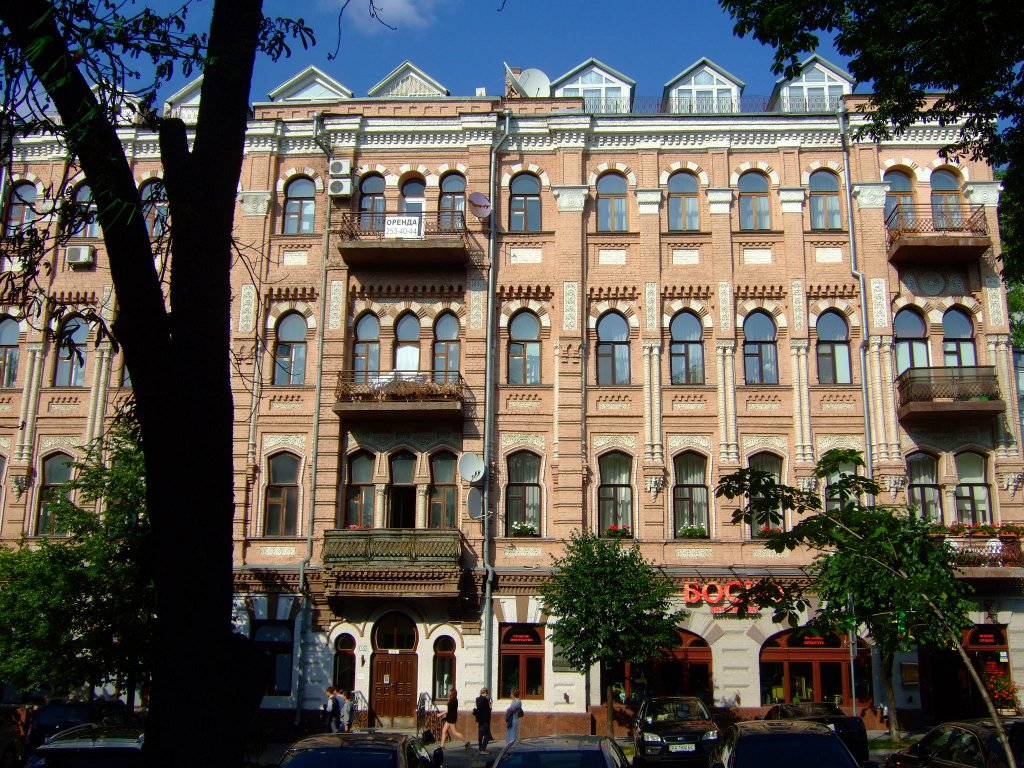
Another building facing Ivan Franko square.
The famous Chimaera house, also known as Gorodetski house (after its architect’s name), in Bankova street. Constructed as Gorodetski’s private upmarket appartment building in the early XXth century, it changed ownership numerous times and at present is used as a presidential residence for official and diplomatic ceremonies. The “Chimaera” name refers to the architectural decoration style, in which animal figures are applied as decorative elements. They were sculpted by Italian architect Emilio Sala.
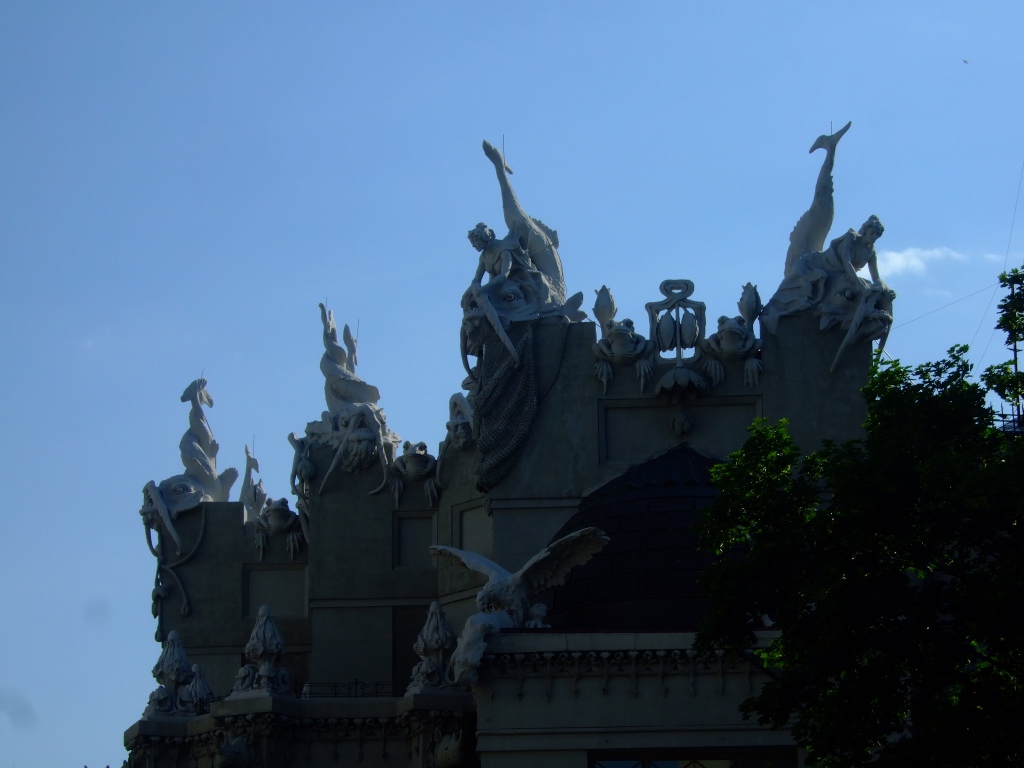
Some of the sculptures in Chimaera house, by Gorodetski architect.
This is also a very nice one:
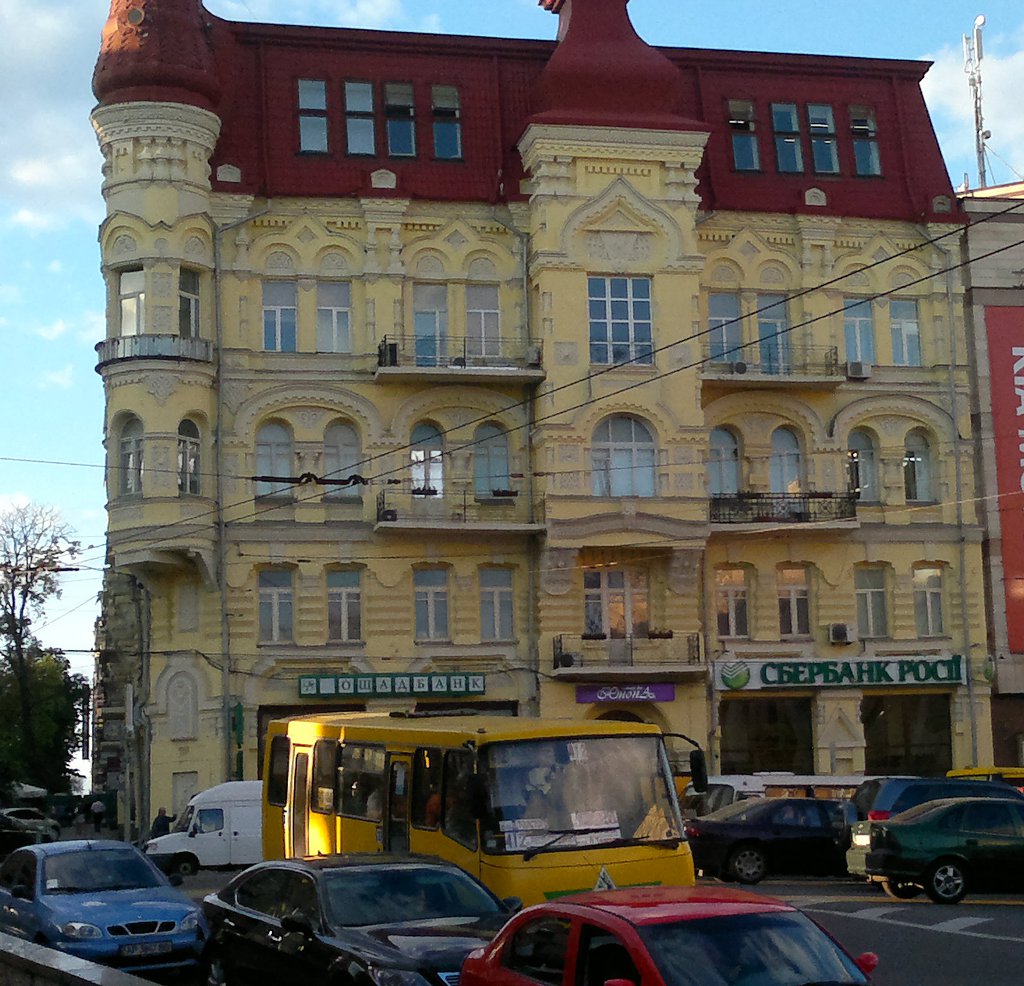
Nice building near Lev Tolstoi metro.
Though not everything is as nice as it looks:

And the garbage piled up in front of it. 🙁
The last sun rays of our building-hunting day brought us some nice final shots:

Somewhere around Lev Tolstoi metro station.

Along Chervonoamiis’ka street.
Of course, when visiting Kiev, the Lavra-Pecherska monastery complex is an absolute must see. But there are way too many good pictures of it already out there in the internet, so ours is just a testimony that we were there:
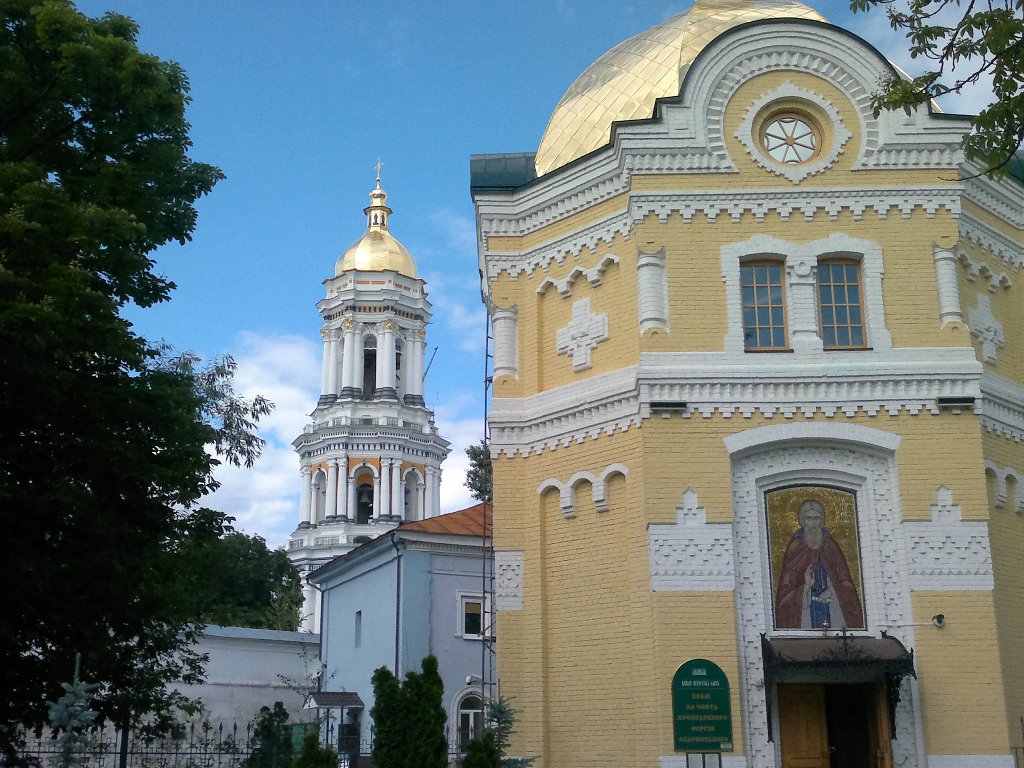
Lavra-Pechers’ka monastery complex.
Dreadful Pilip Orlik’s weapons:
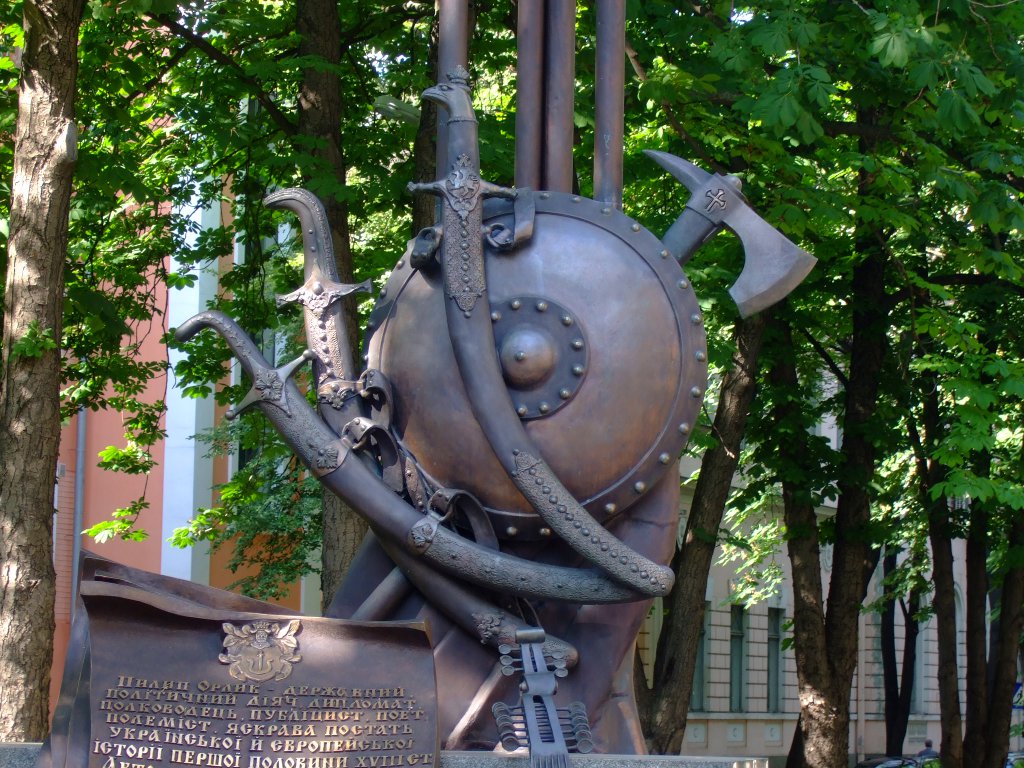
Some dreadful characters:
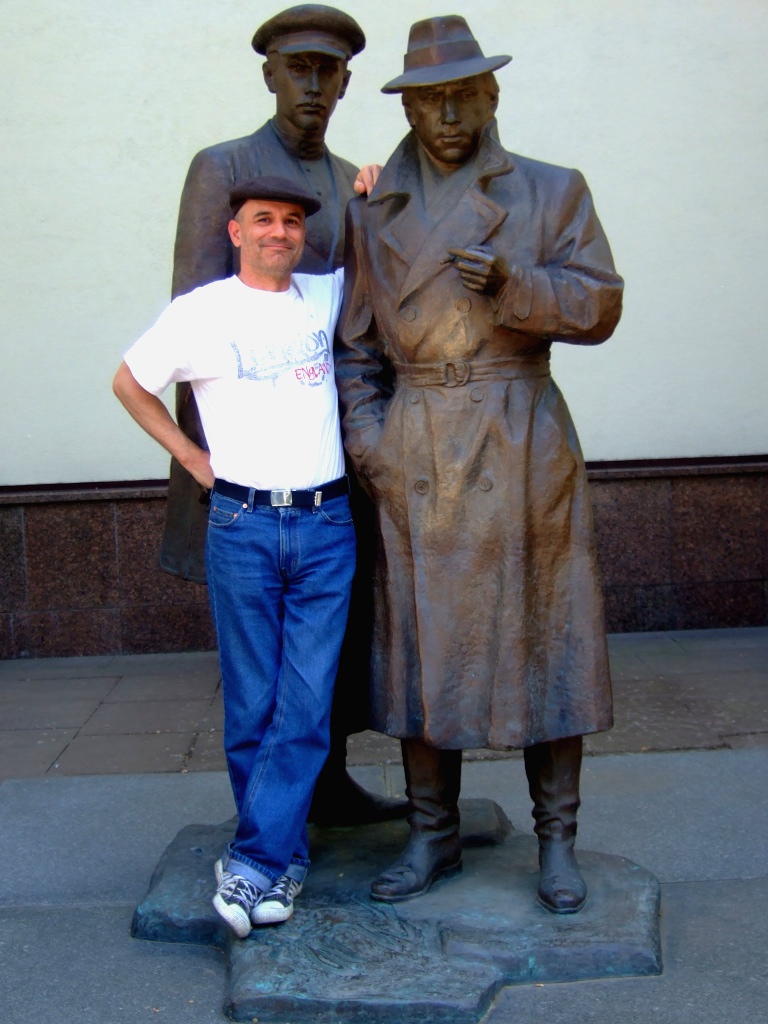
Making friends with mafia and police.
A very bored and a bit angry slavic lady (by the expression of her face, I’d swear she’s Polish) waiting for someone who’s late:
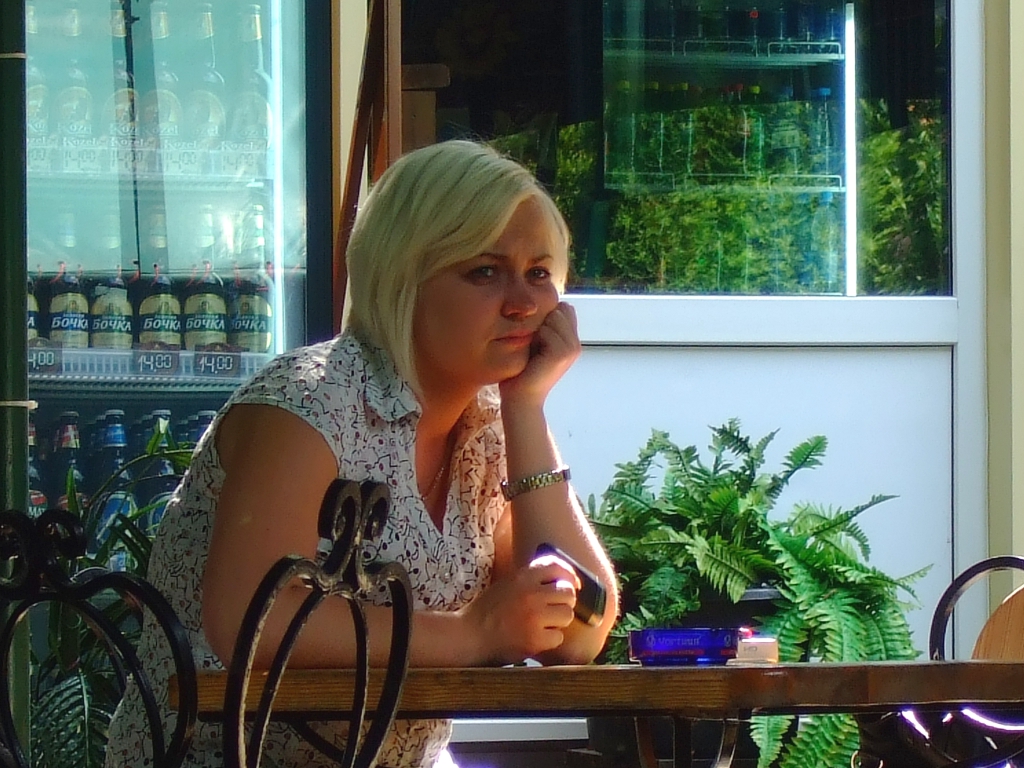
Bored woman sitting in a terrace.
One last evidence of human’s stupidity: 10,000 square metres of deforested area in one of the most beautiful and worthful parks in Kiev. Thousands of trees cut for erecting an unnecessary and boastful building just for the sake of progress, growth and developement. One year ago, the same view from the same spot was all green.
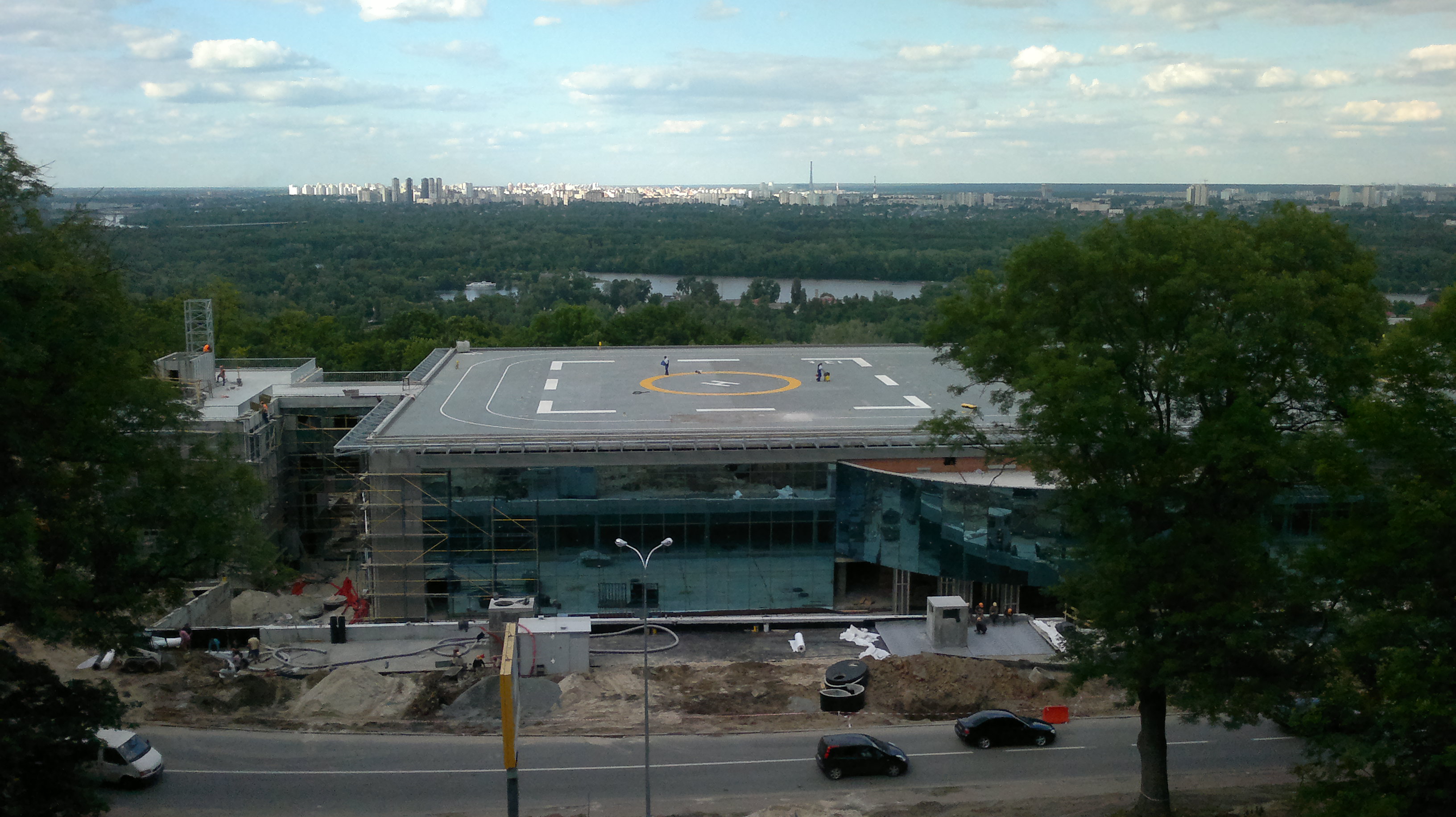
New building with heliport right in the middle of a beautiful park.
And, well, that’s all folks! A final toast to you, from a terrace in Volodimirs’kyii passage, for making me company along this modest slide show:
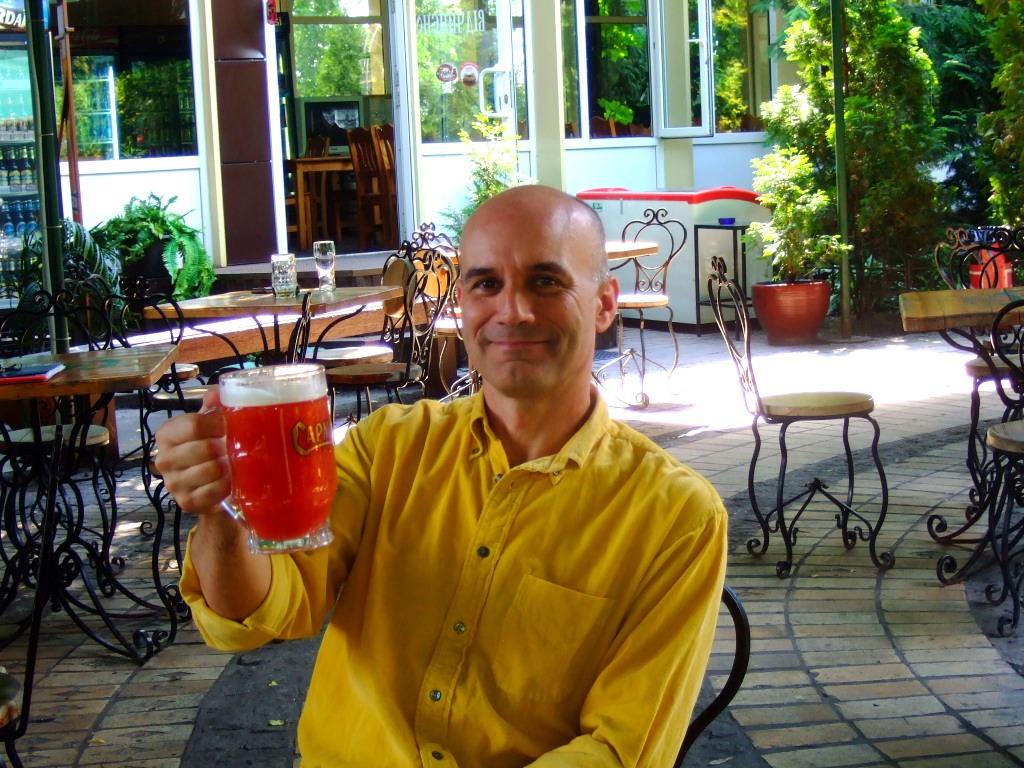
Happy Pablo toasting to you!
.
